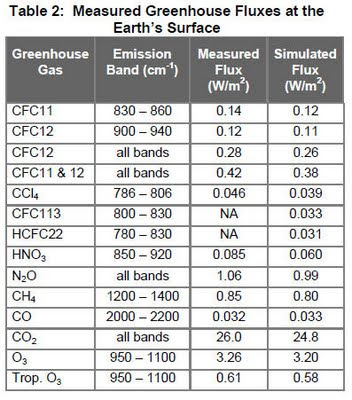An interesting paper from 2006
MEASUREMENTS OF THE RADIATIVE SURFACE FORCING OF CLIMATE
[...]
The measurements have been obtained using commercial Fourier-transform
infrared (FTIR) spectrometers. These measurements have been used to quantify
the radiative flux associated with a number of greenhouse gases. It is this radiative flux that provides an additional source of warming for the planet’s surface, and ultimately is responsible for any change in climate. We
have provided the first direct measurements of the greenhouse effect for a number of trace gases in the atmosphere. These gases include trichlorofluoromethane (CFC-11), dichlorodifluoromethane (CFC-12), carbon tetrachloride (CCl4), methane (CH4), nitrous oxide (N2O), carbon monoxide (CO), nitric acid (HNO3), and tropospheric ozone (Evans and Puckrin, 1994-1997; Puckrin et al., 1996). Not only do these results prove that an increase in the greenhouse effect is real, and that trace gases in the atmosphere areadding a significant radiative burden to the energy budget of the atmosphere, but they also provide a means of validating the predictions that are made by global warming models (Ellingson et al., 1991).
[...]
4. CONCLUSIONS
Measurements of the downward radiative flux have been made for several
important greenhouse gases. At mid-latitudes in summer as compared to winter, our measurements show that the downward surface flux from H2O has doubled to 200 W/m2. The water increase causes a reduction
of the fluxes from the other greenhouse gases. These measurements show that the greenhouse effect from trace gases in the atmosphere is real and adds significantly to the radiative burden of the atmosphere. The greenhouse radiation has increased by approximately 3.52 W/m2 since pre-industrial
times. This compares favorably with a modeled prediction of 2.55 W/m2. Measurements such as these can provide a means by which to verify the predictions made by global warming models (Puckrin et al; 2004).









But this does not explain why the climate has slowly gotten warmer. The primary mechanism of warming is convection. The primary GHG is water vapor but water itself is a moderator and adds to the convection effect. The primary heat absorber is the ocean directly from the sun. Ever try to heat a basin of water with an air heat gun?
ReplyDeleteThe other GHG are trace gases and would have little effect regardless of what is found in the laboratory which is in a closed system. The thermosphere has very hot temperatures but the air molecules are so widely spaced that the watt transfer is negligible.
The canary of the planet are the glaciers. The glaciers of glacier Bay, (among others) in Alaska showed a steady progressive retreat since 1794 when the warming trend started as documented by world renowned Dr. Syun-Ichi Akasofu, emeritus professor of physics, and Founding Director, International Arctic Research Center of the University of Alaska Fairbanks: "Is the Earth Still Recovering from the Little Ice Age?". The Arctic is subject to AMO and PDO cycles which is why the ice pack wanes and grows every 60 some years as part of the Earth temperature climate control system so that is not real indicator of warming.
So since the glaciers have shown steady increase while some have actually advanced there is no correlation to the warming in regards to CO2 increases. In fact, careful measurements show CO2 following temperature increases. The man-made emissions don’t account for the volume of increase either.
The only way heat from the planet can leave the planet is via radiation, Since the planet in general is cool (less than 100°C) this radiation will be in the form of long wave infra red. Unless the planets reflectivity changes significantly (clouds/ice) or the suns output changes the radiation the planet receive will be sensibly constant.
ReplyDeleteConvection will neither allow the planet to cool nor warm it will simply redistribute the heat - there is no convection and no conduction outside the atmosphere. Water vapour is a important ghg but its presence in the atmosphere reduces with falling temperature. Very little water vapour below 0°C
Perhaps you could tell me what takes 400 years to warm from the LIA?